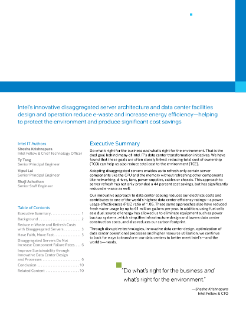Green Computing at Scale
How does Intel achieve green computing at scale? By using innovative disaggregated server architecture and data center facilities design and operation, which reduces e-waste and increases energy efficiency—helping to protect the environment and produce significant cost savings.
Do what’s right for the business and what’s right for the environment. That is the dual goal behind many of Intel
IT’s data center transformation initiatives. We have found that these goals are often closely linked: reducing total cost of ownership (TCO) can help us also reduce total cost to the environment (TCE).
Adopting disaggregated servers enables us to refresh only certain server components like the CPU and the memory without refreshing other components like networking, drives, fans, power supplies, cables or chassis. This approach to server refresh has not only provided a 44 percent cost savings, but has significantly reduced e-waste as well. The disaggregated server architecture is a perfect fit for Intel’s data centers. Just like when a homeowner upgrades lighting, replacing only the bulbs with the most energy-efficient ones without replacing the entire lighting fixture, Intel IT prefers to upgrade just the compute modules with the latest technologies without replacing the entire server infrastructure.
Our innovative approaches to data center cooling include free-air cooling and close-coupled evaporative cooling. These techniques reduce our electrical costs and contributes to one of the world’s highest data center efficiency ratings—a power usage effectiveness (PUE) ratio of 1.06. These same approaches also have reduced fresh water usage by up to 61 million gallons per year. In addition, using fuel cells as a dual source of energy has allowed us to eliminate equipment such as power backup systems, which simplifies infrastructure design and lowers data center construction costs, and also reduces our carbon footprint. Through disruptive technologies, innovative data center design, optimization of data center operational processes and higher resource utilization, we continue to look for ways to transform our data centers to better meet Intel’s—and the world’s—needs.
As Shesha Krishnapura, Intel Fellow & CTO, says, “When you talk to the CIOs of the world, what you hear is digital transformation and most of the focus is on the application side. But what these people miss is the transformation at the infrastructure level."
Intel’s business needs will continue to increase, and we will likely continue to see double-digit growth in the demand for compute and storage. And yet, the global challenges facing the IT industry, such as climate change, e-waste and responsible water usage continue to mount as well. “Green computing” is more than just pursuing the lowest possible PUE; it encompasses a broad range of initiatives and concepts. By adopting disruptive technologies like disaggregated servers and constantly thinking outside the box about how we operate our data centers, Intel IT is proving that the concepts of operationally efficient (TCO) and environmentally friendly (TCE) are often more closely linked than many people may suspect.
